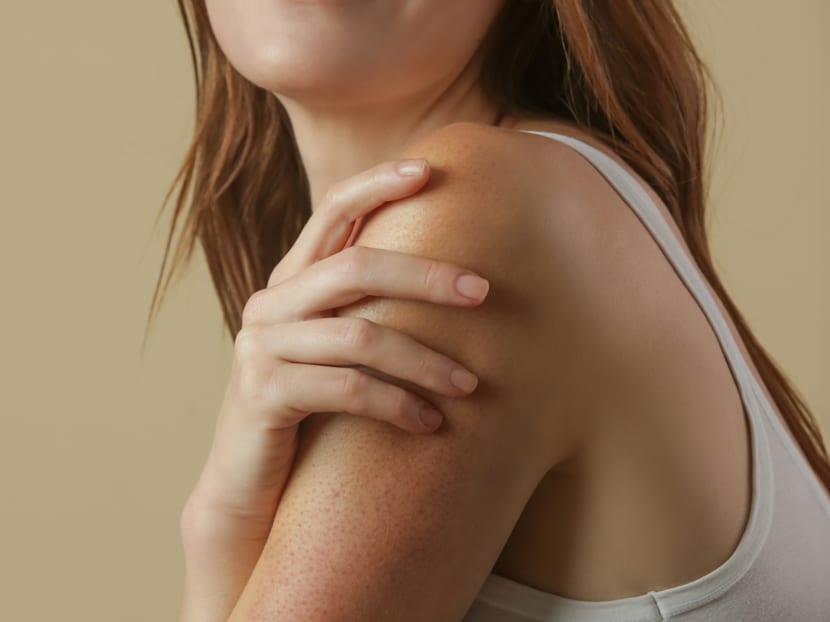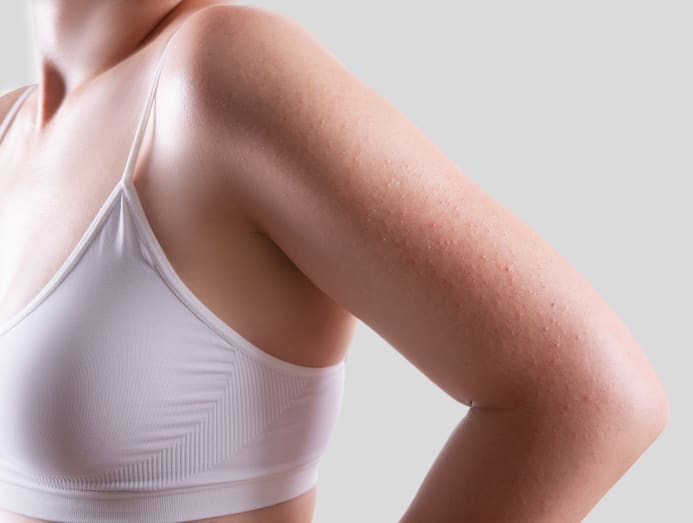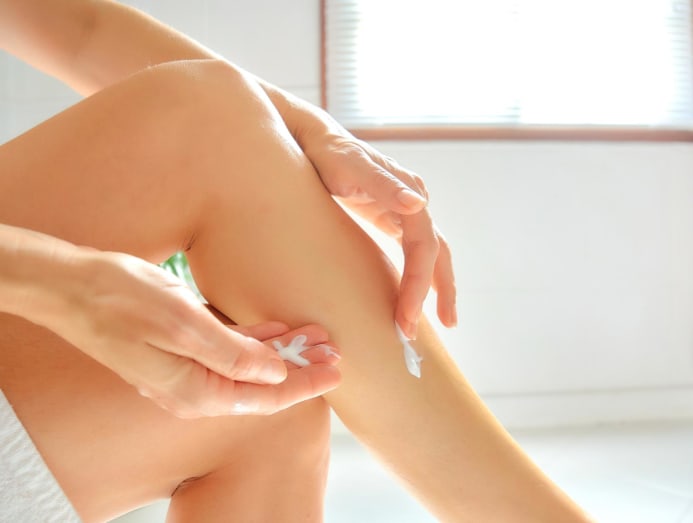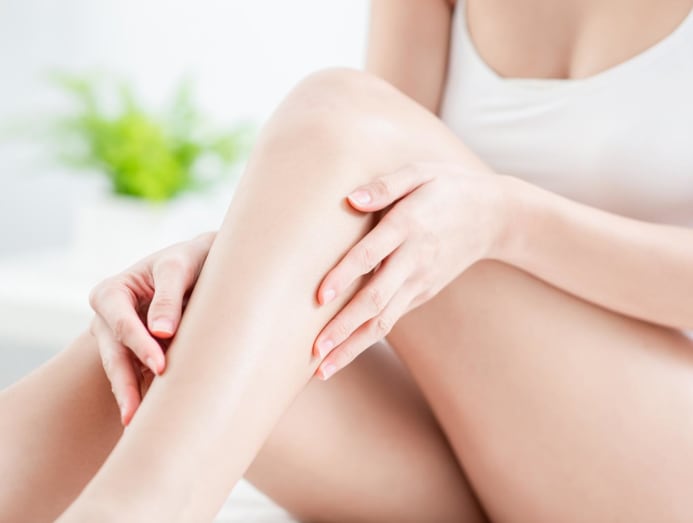Got rough, bumpy patches on your arms and thighs? Here’s how to deal with 'chicken skin'
Good news – this skin condition, known as keratosis pilaris, is likely to resolve itself with age, but in the meantime, follow this dermatologist’s advice on managing it.

How to deal with 'chicken skin'. (Photo: iStock)

This audio is generated by an AI tool.
Keratosis pilaris is a skin condition that causes tiny, raised bumps to appear in patches all over the skin, giving it a rough and “goosebump-y” appearance – which explains for why it’s commonly referred to as “chicken skin”.
While it may not be quite as bad as eczema, admittedly, it can mar the appearance of your skin. Which is why those who suffer from it are always on the lookout for ways to be rid of it.
According to Dr Angeline Yong, a dermatologist at Angeline Yong Dermatology, keratosis pilaris is a benign condition, although it does affect the look and texture of the skin.
“These bumps, which can vary in colour – from skin-toned to red or brown, are usually the result of excess keratin, a protein that protects the skin from infections and other harmful substances. This excess keratin accumulates around hair follicles, leading to blockages,” she explained.
Keratosis pilaris causes tiny, raised bumps to appear in patches all over the skin, giving it a rough and “goosebump-y” appearance.
This skin condition typically does not cause significant itch or pain, and isn’t accompanied by inflammation – the bumps are usually painless and may only become mildly itchy in some individuals, particularly if the skin is dry or irritated. In other words, the primary symptoms are the raised bumps and rough texture, rather than discomfort.
“While keratosis pilaris primarily affects the arms, thighs and other areas of the body, it can also appear on the face, particularly on the cheeks – although this is less common. It's important to differentiate keratosis pilaris on the face from other skin conditions, such as acne or eczema. If keratosis pilaris is suspected on the face, a dermatologist can help confirm the diagnosis and recommend appropriate management strategies,” she cautioned.
If you’re suffering from keratosis pilaris and have been struggling with trying to minimise the bumpy appearance it’s giving your skin, here’s what you need to understand about it and also what you can do to alleviate it.
WHAT CAUSES KERATOSIS PILARIS?

It is a common skin condition, especially among adolescents and young adults. The causes can vary, and include factors such as age, skin type, as well as genetic background.
“Keratosis pilaris is especially prevalent in people with dry skin and those who have a family history of the condition. While it can also occur in individuals of any skin type and age, it is often most noticeable during adolescence and young adulthood. Despite its prevalence, many people may not seek treatment for it, as it is generally harmless and often resolves or becomes less noticeable with age,” said Dr Yong.
The reason for the condition going away as one grows into adulthood is not fully understood, but generally thought to be due to a natural decrease in keratin production as the body ages.
These bumps, which can vary in colour – from skin-toned to red or brown, are usually the result of excess keratin.
WHAT YOU CAN DO AT HOME TO MANAGE IT

First of all, it’s important to know that there’s no immediate “cure” to completely eliminate bumps resulting from keratosis pilaris. That said, there are simple ways, however, to improve how they look and feel on the skin. Here are some recommendations from Dr Yong.
1. MOISTURISE
Dry skin can exacerbate the appearance of the bumps of skin, which is why maintaining the skin’s moisture balance is your essential goal. Applying moisturiser after your bath or shower can help skin lock in moisture and keep it hydrated.
Regular use of body lotion or cream can help soften the bumps and improve the overall texture of the skin. Look for thick, creamy formulations that contain ingredients like urea, lactic acid and glycerin.
2. EXFOLIATE
Using a body scrub regularly can help remove dead skin cells and prevent the buildup that causes keratosis pilaris. It is important to choose an appropriate product for your skin type that will not cause irritation or skin damage.
Physical exfoliants that contain granules are acceptable for use if you have generally normal skin, although it’s advisable to avoid those that feel too rough on the skin. If you have sensitive or dry skin, opt for chemical exfoliators that provide a gentler exfoliating action – these will contain alpha-hydroxy acids like glycolic acid or lactic acid, or beta-hydroxy acids like salicylic acid, which can penetrate deeper into hair follicles.
Remember to always moisturise after exfoliation – doing so will help soothe, protect and restore hydration to the skin.
“Treating keratosis pilaris often requires regular and consistent use and application of products. Improvements can take time, so patience is key,” noted Dr Yong. She also cautioned against using harsh soaps or other aggressive treatment products that can worsen the condition.
NO IMPROVEMENT? SEEK A DERMATOLOGIST’S HELP

If consistent DIY care at home isn’t doing much to help change how your skin looks, consider going to a dermatologist, who can prescribe and administer medical-level treatments, or check your skin properly to confirm if it’s actually affected by keratosis pilaris, or also by other skin issues. Here’s what Dr Yong says a dermatologist can do to minimise the impact of this skin condition more effectively.
1. TOPICAL TREATMENTS
A dermatologist can provide prescription creams that include stronger formulations of AHAs or BHAs, or retinoids that will help to promote cell turnover and reduce the build-up of keratin in hair follicles.
2. CHEMICAL PEELS
If a more intensive exfoliation is required, a dermatologist may perform in-clinic chemical peels using stronger AHAs or BHAs to exfoliate the skin more deeply.
3. LASER THERAPY
In some cases, laser treatments such as long-pulsed laser or CO2 fractional laser may be utilised to improve skin texture and minimise the appearance of bumps on skin.




